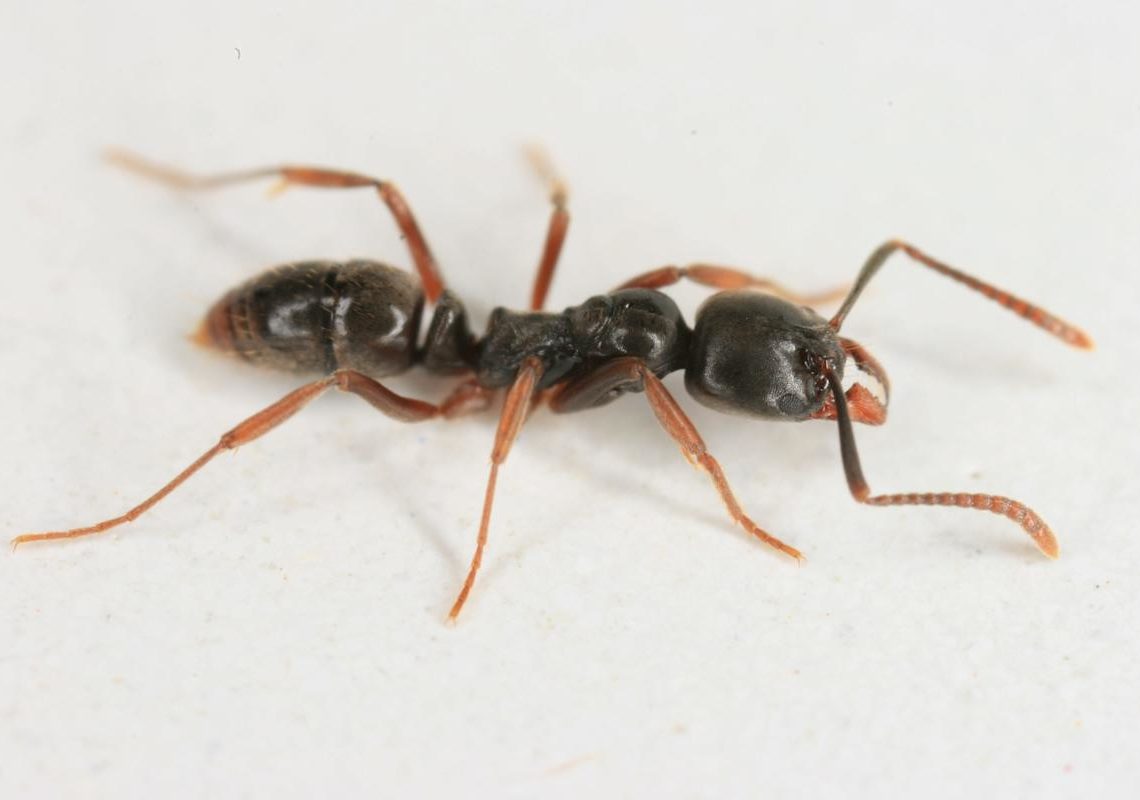An invasive species of stinging, carnivorous ants have been slowly spreading in about 20 states.
Last year at least three cases of life-threatening anaphylactic reactions were reported in Georgia, making this little (and little-known) insect a growing problem.
“Asian needle ants” will reach their yearly peak numbers in July and August, but it will still be tough to spot them, even if you get stung by one. They are so small and blend in so well that stings often occur when someone — perhaps while gardening or moving wood – unknowingly disturbs them.
“Imagine somebody inserting a needle directly into your flesh,” said Benoit Guénard, a professor of ecology and entomology at the University of Hong Kong who studied the ants in North Carolina. “It’s a very sharp, acute pain but it’s quite local.”
Tracking them has long been a challenge, but researchers now say the spread of the Asian needle ant shouldn’t be ignored.
“They’re pretty widespread on the East coast,” said. Daniel Suiter, a professor of urban entomology at the University of Georgia. “If you live in an area which is dominated by hardwood trees, there’s a good chance there are Asian needle ants underfoot.”
For some, the stings can be life-threatening. For others, it’s an unusual pain that can come and go for hours.
That’s just one of the mysteries of Brachyponera chinensis — roughly translated as “short, wicked ant from China” – though they’re actually native to China, Japan and the Koreas.
Hard to track, hard to kill
The invasive insect was first discovered in the United states in 1932 in Decatur, Georgia, but was only recognized as a serious pest in the past two decades as it began to spread significantly throughout the southeast. Now it’s found as far north as Connecticut and as far south as Florida, as well as in Wisconsin and Washington state, according to the site antmaps.org. There are reports they have also appeared in Texas.
These ants are carnivorous, seeking out prey such as flies, beetles, grasshoppers and their favorites: termites. Given their hunting habits, they don’t lay down scent trails as some ants do, making it difficult to track them back to their colonies and eradicate.
“Most ants are in-your-face invasive, they lay a pheromone trail to get to food. You can’t miss an ant trail that’s half an inch wide,” said Suiter. “These remain hidden.”
The dark brown ants live in colonies in leaf litter, rotted logs, firewood and mulch. They often occur in residential settings, including parks, and urban areas, finding homes and under railroad ties, logs, bricks, and pavers. They can also nest in potted plants, under wood piles, and in lawns.
“People are most often stung when they’re working in their garden,” said Theresa Dellinger, a diagnostician at the insect identification lab at Virginia Polytechnic Institute. “Nobody likes to be putting in their bedding plants and then suddenly have unexpected pain.”
The worker ants’ bodies are about 0.2 inches long, small, dark and shiny but with lighter orange legs and antennae. “They have a long jaw and a big stinger on the business end,” Dellinger said.
Although they’re relatively long and thin, the “needle” in their name actually comes from their Japanese name, Oo-hari-ari, which means “giant needle ant” and refers to size of their stinger, she said.
It’s very possible to learn to live with Asian needle ants, just as we’ve learned to live with bees, said Andrew Johnston, an insect diagnostician at Purdue University’s Department of Entomology.
“They’re not aggressive, they don’t swarm the way fire ants do,” he said. “Wear gloves and pay attention to what you’re grabbing.”
Because the ants like to live in moist areas and around wood, keeping loose logs and firewood up off the ground so they stay dry is one way to avoid infestations, said Suiter.
And if you’re sensitive to insect stings, suggests Dellinger, “carry an EpiPen.”
A painful, long-lasting sting
Guénard has been stung by many different ant and insect species but said Asian needle ants are the only ones he knows of where the pain is very acute at first, then disappears and then can come back over and over again.
“The first, initial pain lasted a few seconds. Then about five minutes later, when the pain had eased, I felt ‘ouch!’ as if somebody had stung me again in the same place. The pain continues to reoccur in the same place, it disappears and then comes back,” said Guénard.
“For me, it goes on for about two hours,” he said. “But I know in some people it lasts for as much as 24 to 48 hours.”
In a small number of cases it can also be deadly. The sting can cause allergic reactions and in 1% of victims, the venom can result in deadly anaphylactic shock.
Decades of mystery
There’s a lot researchers don’t yet understand about why these invasive ants only began to significantly spread in the United States in the 1980s and 1990s.
Native to China, Japan and Korea, the Asian needle ant was first identified in Georgia in 1932 but probably arrived here well before that.
“It’s very likely the ants were introduced in the early 20th century because by 1934 they were already found in three states, so clearly they hadn’t just arrived,” Guénard said.
Because they live in dirt and mulch, Guénard speculates that they might have come into the United States in the root balls of trees being imported from Asia.
What puzzles researchers is the timing of their spread. The ants remained relatively localized well into the 1970s, research shows. In 1962 a very thorough inventory of the ants of North Carolina was conducted by entomologist W. G. Carter.
“He never found them,” said Guénard.
Then between 1991 and 2017, Asian needle ants spread across North Carolina and are now found across the state.
“Something happened,” Guénard said. “I could not tell you exactly what.”
The spread of this invasive species is causing ecological damage as they spread, research shows. Because they are predators, Asian needle ants hunt native insects that have evolved to have important roles in local ecosystems.
For example, while no one wants termites in their home, in the forest they are critical part in the health of the woods. “They’re very important because they help with the decomposition of dead wood and other organic matter,” Guénard said.
Research has also shown that local native ants are an important part of seed dispersal for some plant and tree species. If the Asian needle ants take over their territory, the seeds don’t get spread.
“The seeds just die rather than being dispersed,” he said.
As the climate warms and becomes wetter in some areas, the extent of where these ants can thrive is growing and they’re expected to invade new regions. The amount of North America that could become suitable is expected to increase as much as 75% over the next 50 or so years, according to Guénard’s previous research.
How dangerous are Asian needle ants?
Asian needle ants aren’t as aggressive as fire ants and will mostly just run away when they encounter humans. However, they will defensively sting if they feel pressure, for example from someone reaching into a pile of wood, mulch or soil near their nest.
The ants can pose a health risk because their venom can produce allergic reactions in some individuals. Virginia Tech encourages anyone who is allergic to bee stings to seek immediate medical attention if they begin to experience breathing problems or other allergic reactions after being stung by an Asian needle ant.
A survey of people who live in an ant-habitat area of Korea found that 2.1% of those bitten experienced systemic allergic reactions, including 1.2% who went into anaphylaxis. The danger appeared to be highest in people who had experienced repeated stings over time.
There is no national repository of Asian needle ant health problems, but when Guénard maintained a website about the insects while he was conducting research in North Carolina, he received reports of 21 cases of health problems, in Georgia, Kentucky, Mississippi, North Carolina, South Carolina, Tennessee and Washington. D. C. Of those case, at least 12 individuals reported having severe allergic reactions including anaphylactic shock.
The cases involved people moving logs, gardening and even while swimming, when young female ants flying to establish new colonies fell into swimming pools. The stinging events were especially frequent during the summer swarming period from April to September, with a peak in May to July.
In Georgia, Suiter got three calls about cases of anaphylactic shock after Asian needle ant stings last year. “I fully expect that some people who end up in the emergency room were stung by them but didn’t realize it,” he said.
There is concern that people who are hypersensitive to other stinging insects may be at an increased risk of anaphylaxis from Asian needle ants.
Symptoms reported by the USDA can include:
-
Skin reactions include hives, itching, and flushed or pale skin.
-
Low blood pressure (hypotension).
-
Constriction of the airway, wheezing, and difficulty breathing.
-
Swollen tongue or throat.
-
Nausea, vomiting, or diarrhea.
-
Psychological symptoms, such as a feeling of impending doom.
Unlike stings from invasive fire ants, the sting of an Asian needle ant does not produce a blister.
What can you do about Asian needle ants
This particular variety of ant is more difficult to eradicate than other ant species because they don’t lay pheromone trails that can be disrupted or easily used to get the ants to take poison back to their nests.
Instead they use a process known as tandem carrying.
“One worker ant will pick up another worker ant and drag it over to the food source to show it where it is,” Dellinger said.
That makes baiting them difficult, especially because their colonies – typically fairly small and flat – are hard to spot. “We suggest a protein-based bait for this species, and it can take some time for these ants to take the poison back to the colony,” she said.
So far there is no formalized management recommendation for the species. One study published found good luck with using bait that included extracts from termite skin.
Dellinger said broad spraying isn’t helpful and will actually harm other important garden species. “Try to treat the nest,” she said.
Management, rather than eradication, is the goal. That can include removing mulch in areas where the ants might pose a problem, elevating woodpiles so they’re not damp underneath, carefully watching for colonies (which can take time) and only baiting areas where there are definitely ants.
It’s also not easy to identify the Asian needle ants as they look similar to other ant species. “There are a lot of ants out there,” Dellinger said. “We get out the microscope.” She recommended contacting the local agricultural extension if identification isn’t certain. “It’s a free service and they can help identify what’s on your property.”
This article originally appeared on USA TODAY: Stinging and ‘wicked’ Asian needle ants spreading across the US
The post Stinging and ‘wicked’ Asian needle ants are spreading across the US appeared first on USA TODAY.




